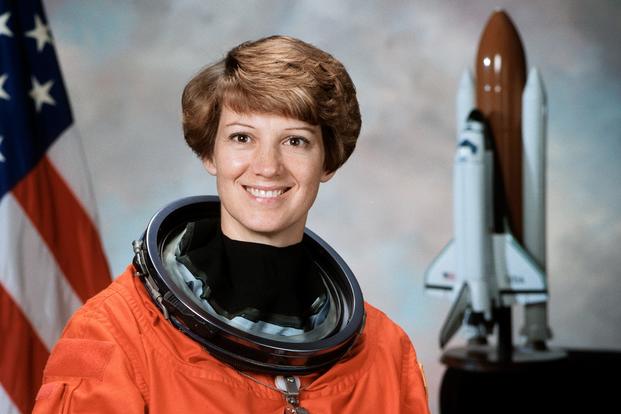The word "pioneer" doesn't even begin to describe properly all that retired Col. Eileen Marie Collins (USAF) continues to accomplish. Clearly, even from a young age, Collins was on a trajectory to smash through records and barriers, not only for women, but for science.
She's a classic example of someone who always knew what she wanted to be. As a little girl, she recalls her first inspiring memories of the Gemini space program in the mid-1960s.
She devoured books about flying, especially on Amelia Earhart, and used to come straight home from school and watch "Star Trek" whenever she could. In high school, Collins paid for her flying lessons by working at a local pizza joint.
"When I was a child, I dreamed about space; I admired pilots, astronauts, and I've admired explorers of all kinds. It was only a dream that I would someday be one of them," she said at a White House ceremony honoring her in 1998. "When I was very young and first started reading about astronauts, there were no women astronauts."
However, Collins was inspired as a child by the Mercury astronauts, and by the time she was in high school and college, new opportunities were opening for women in aviation. "My timing was really great," she said.
Collins joined the Air Force, and during her first month of training, her base was visited by the newest astronaut class -- the first to include women -- and her path was set. "I wanted to be part of our nation's space program. It's the greatest adventure on this planet -- or off the planet, for that matter. I wanted to fly the space shuttle."
After graduating from Syracuse University in New York, she was one of four women chosen for undergraduate pilot training at Vance Air Force Base, Oklahoma. After earning her pilot wings, she stayed on at Vance for three years as a T-38 Talon instructor pilot before transitioning to the C-141 Starlifter at Travis Air Force Base, California.
From 1986 to 1989, Collins was assigned to the U.S. Air Force Academy in Colorado, where she was an assistant professor in mathematics and a T-41 instructor pilot. In 1989, Collins became the second female pilot to attend the U.S. Air Force Test Pilot School and graduated with class 89B. She was selected for the astronaut program in 1990.
According to NASA, when asked about her historic accomplishment of being the first woman space shuttle commander, she said, "Hopefully not for long!" While the distinction of being the first is an honor, Collins said she's looking forward to no longer being the "only" female commander. She said she hopes current astronaut Pam Melroy will soon join her, and that more will follow. "I'm really pulling for her," Collins said.
Collins said she encourages young women to become test pilots so that they can someday become shuttle commanders as well. "The young people are going to be the ones to take us on to more exciting adventures," she said.
When asked what advice she would give to young people, she said: "Go into the field you are most interested in. If you love your job, you'll do well in your job." While coming from a mathematics, science or technology background is a must, there's a lot of variety in what exactly you can pursue.
In fact, Collins discourages people from looking at what other astronauts are in and choosing that. The exact opposite worked for her; when she joined the corps, no astronauts were in her field, operations research. "I said I think I can fill a void, and I think they bought it." It's paid off, too, she said, since much of her background ties in directly to the operation of the shuttle.
When Collins goes to speaking engagements, one of the most commonly asked questions is about the most exciting part of space travel. "If you had asked me this question after my first mission, I would have said the launch," Collins said. "Now, I would say seeing the successful completion of the mission."
As an example, she cited the first mission she commanded, STS-93, on which the Chandra X-Ray Observatory was deployed. So many people were involved in the Chandra project and the launch, she said, and it's been really rewarding seeing the amazing pictures that Chandra has taken.
"Everybody came together and made it happen," Collins said.
Biographical data (courtesy of NASA)
-- Hometown: Elmira, New York
-- Born: Nov. 19, 1956
-- Education: Associate's degree in mathematics/science from Corning Community College; bachelor's degree in mathematics and economics from Syracuse University; master's degree in operations research from Stanford University; master's degree in space systems management from Webster University.
-- Spaceflight experience:
- Pilot, Discovery STS-63: Collins became the first female shuttle pilot during this 1995 mission, which included a rendezvous with the Russian Space Station Mir.
- Pilot, Atlantis STS-84: This 1997 mission transferred supplies to the Mir Space Station.
- Commander, Columbia STS-93: Collins became the first female shuttle commander on this 1999 mission, which included the deployment of the Chandra X-Ray Observatory.
Want to Learn About More Famous Veterans?
Whether you want to learn more about other famous veterans, polish up your resume, find veteran job fairs in your area, or connect with employers looking to hire veterans, Military.com can help. Sign up for a free Military.com membership to have job postings, guides and advice, and more delivered directly to your inbox.











